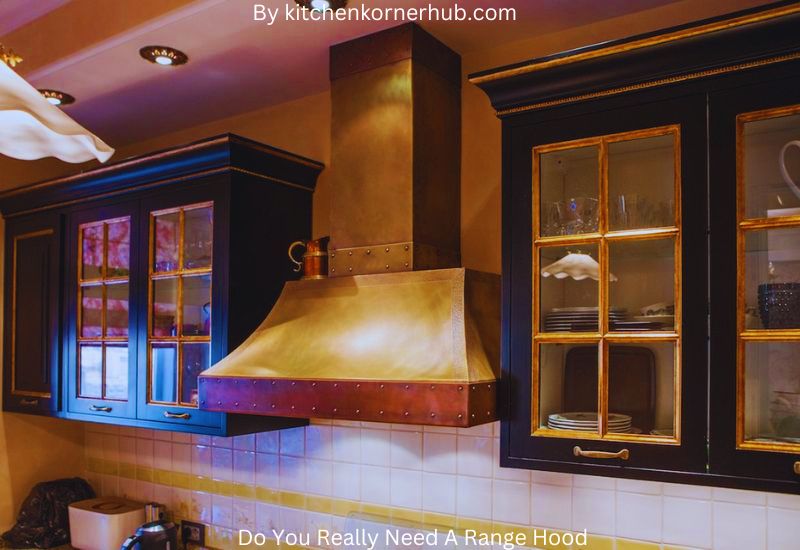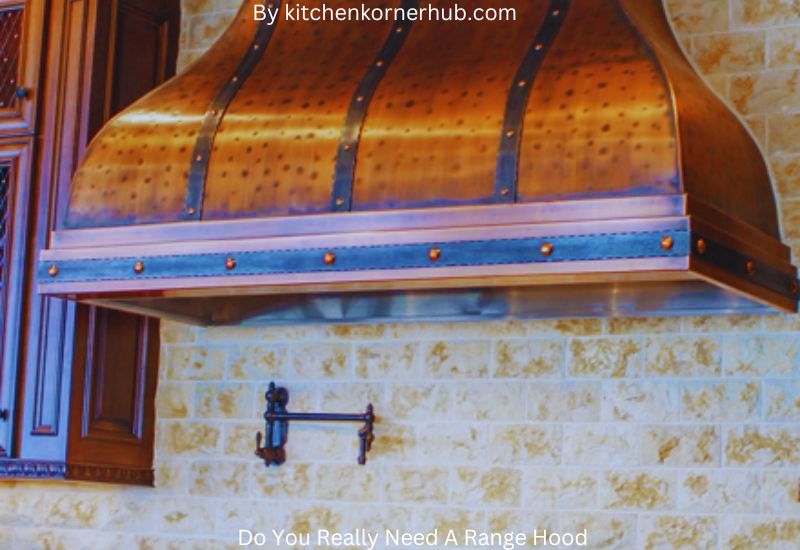Introduction:
Have you ever wondered if that large contraption hovering over your stove, known as a range hood, is actually necessary? While it might seem like just another kitchen appliance, a range hood serves a vital purpose beyond adding a touch of modernity to your cooking space. In this discussion, we’ll explore the reasons why a range hood could be more than just a fancy addition, but a practical and essential component of your kitchen setup.
Do You Really Need A Range Hood? A range hood is beneficial for removing cooking odors, smoke, and airborne grease particles from your kitchen. It also helps improve indoor air quality and prevents the buildup of grease on surfaces. If you cook frequently, a range hood can be a valuable addition to your kitchen.
Range hoods, also known as vent hoods or exhaust hoods, are designed to do more than simply collect cooking odors and channel them outside. They play a crucial role in maintaining indoor air quality, preventing the buildup of potentially harmful pollutants, and ensuring that your kitchen remains a comfortable and safe environment to cook in. From trapping grease particles to reducing excess moisture and minimizing the risk of fire hazards, a range hood offers a range of benefits that extend beyond mere aesthetics.
Importance of Kitchen Ventilation

Introduction
Kitchen ventilation is an essential component of a well-designed culinary space, often overlooked but bearing significant importance for health, safety, and overall comfort.
A proper ventilation system effectively removes odors, smoke, heat, and airborne contaminants generated during cooking, thereby creating a healthier and more pleasant cooking environment.
Health and Air Quality
One of the primary reasons for installing a robust kitchen ventilation system is to maintain indoor air quality. Cooking activities release various pollutants, including volatile organic compounds (VOCs), carbon monoxide, and grease particles. Without proper ventilation, these pollutants can accumulate, leading to respiratory issues, allergies, and other health concerns.
A well-functioning ventilation system effectively removes these pollutants, preventing their build-up and ensuring a healthier living environment.
Odor and Grease Control
Cooking often involves the release of strong odors that can permeate throughout the home. Over time, these odors can become pervasive and unpleasant.
A kitchen ventilation system equipped with a quality exhaust fan and filters helps eliminate cooking odors, preventing them from spreading to other living areas. Additionally, the system captures and removes grease particles that can accumulate on surfaces and appliances, making cleaning tasks less burdensome and ensuring a cleaner kitchen overall.
Temperature Regulation
The cooking process generates a significant amount of heat, which can quickly make a kitchen uncomfortable, especially during the warmer months. An efficient kitchen ventilation system not only removes the hot air but also aids in maintaining a comfortable temperature.
By expelling heat and bringing in fresh air from outside, the system creates a more conducive environment for the cook and prevents the rest of the home from becoming excessively warm.
Fire Safety
Kitchens are susceptible to grease fires, which can spread rapidly and cause substantial damage. A well-designed kitchen ventilation system, including a range hood with a fire suppression feature, can help contain and extinguish such fires before they escalate.
The system’s fire suppression feature detects flames and automatically triggers measures to suppress the fire, preventing it from spreading and minimizing potential harm.
Energy Efficiency
Contrary to the misconception that ventilation systems consume excess energy, modern designs incorporate energy-efficient technologies. Heat recovery ventilators, for instance, allow for the exchange of indoor and outdoor air while minimizing heat loss during colder months.
Additionally, smart ventilation systems can adjust their operation based on cooking intensity, ensuring optimal performance without unnecessary energy consumption.
The Functionality of a Range Hood

In modern kitchens, the range hood has evolved from a mere accessory to an essential appliance that plays a crucial role in maintaining a clean and healthy cooking environment.
Its functionality extends beyond its aesthetic appeal, as it serves several important purposes that contribute to a pleasant and safe cooking experience.
Ventilation and Smoke Removal:
One of the primary functions of a range hood is to effectively remove smoke, steam, and cooking odors from the air. When cooking, especially at high temperatures or when frying, a variety of airborne particles are released, including grease, smoke, and volatile organic compounds.
A range hood with a powerful exhaust fan helps to quickly capture and expel these particles, preventing them from spreading throughout the kitchen and the rest of the home.
Heat and Humidity Control:
Cooking generates heat and humidity, which can make the kitchen uncomfortable and even affect the overall indoor climate. A range hood helps to control the temperature and humidity levels by removing the excess heat and moisture produced during cooking.
This not only creates a more comfortable environment for the chef but also helps in maintaining the structural integrity of the kitchen by preventing excessive moisture buildup that could lead to mold and mildew growth.
Grease and Particle Filtration:
Range hoods equipped with filters play a vital role in trapping grease and airborne particles. Grease particles can accumulate on surfaces around the kitchen, creating a sticky and unsightly mess. Moreover, these particles can contribute to poor indoor air quality and even pose a fire hazard.
The filters in a range hood capture these particles, preventing them from settling on surfaces and reducing the risk of grease-related accidents.
Improved Air Quality:
Cooking releases not only visible particles but also invisible pollutants like carbon monoxide and various volatile organic compounds. Inefficient ventilation can lead to poor indoor air quality, which may result in health issues and discomfort.
A properly functioning range hood helps to remove these pollutants, ensuring that the air in the kitchen remains clean and safe to breathe.
Fire Safety:
The cooking process involves the use of open flames and high heat, making the kitchen susceptible to potential fire hazards. Grease buildup in the kitchen can ignite and cause fires.
A range hood with a fire-resistant design and proper ventilation can effectively reduce the risk of fires by capturing and removing grease particles and steam that can contribute to flames.
Benefits of Installing a Range Hood

A range hood, often overlooked but highly valuable, is a kitchen appliance that offers numerous benefits to homeowners.
Beyond its primary function of eliminating cooking odors and smoke, a range hood contributes significantly to the overall kitchen environment, health, and even energy efficiency.
Improved Air Quality:
One of the foremost advantages of installing a range hood is the enhancement of indoor air quality. Cooking generates a variety of airborne particles, such as grease, steam, and smoke, which can lead to unpleasant odors and potentially harmful pollutants.
A range hood effectively captures and filters these particles, preventing them from spreading throughout the home and improving the quality of the air you breathe.
Healthier Environment:
Cooking fumes, if not properly managed, can contain harmful substances like carbon monoxide and volatile organic compounds (VOCs). Long-term exposure to these pollutants can lead to various health issues, including respiratory problems and allergies.
By installing a range hood with efficient ventilation and filtration systems, you can create a healthier environment in your kitchen, reducing the risk of health-related complications.
Protection for Kitchen Surfaces and Cabinetry:
Cooking activities, particularly those involving high heat and oil, can result in the buildup of grease and grime on kitchen surfaces and cabinetry. Over time, this can cause discoloration, deterioration, and even damage.
A range hood helps mitigate this problem by extracting the grease and airborne particles directly from the cooking area, preventing them from settling on surfaces and extending the lifespan of your kitchen fixtures.
Enhanced Safety:
In addition to improving air quality, a range hood plays a crucial role in maintaining kitchen safety. Cooking generates heat, steam, and potentially hazardous gases. A range hood helps dissipate heat and steam, preventing excess moisture from accumulating and potentially causing problems like mold growth.
Furthermore, it aids in the removal of potentially flammable grease particles, reducing the risk of kitchen fires.
Energy Efficiency:
Modern range hoods often come equipped with energy-efficient features, such as adjustable fan speeds and LED lighting. These features not only contribute to a greener household by reducing energy consumption, but they also offer cost savings over time. LED lights, for instance, consume less energy than traditional incandescent bulbs and last much longer, reducing the need for frequent replacements.
Contaminants and Pollutants in Cooking Air

Cooking is an essential activity in every household, serving as a means to prepare nourishing meals. However, it also gives rise to a range of contaminants and pollutants that can significantly degrade indoor air quality. Understanding these sources and their potential health impacts is crucial for creating a healthier living environment.
Particulate Matter (PM):
One of the most common pollutants released during cooking is particulate matter, abbreviated as PM. These microscopic particles can originate from various sources such as burning oil, grilling, frying, and even toasting.
In the form of ultrafine particles, they can infiltrate deep into the respiratory system, potentially causing respiratory issues, exacerbating allergies, and affecting cardiovascular health. A proper ventilation system with effective filters can help mitigate the adverse effects of PM.
Volatile Organic Compounds (VOCs):
The process of cooking emits VOCs, which are organic chemicals that evaporate into the air at room temperature. These compounds can arise from the cooking process itself or from the ingredients being used, including oils, spices, and meats.
VOCs contribute to indoor air pollution and have been linked to both short-term and long-term health problems, ranging from eye and throat irritation to more severe issues like cancer and organ damage. Adequate ventilation and choosing cooking methods with lower emissions can help control VOC levels.
Carbon Monoxide (CO):
Incomplete combustion of fuels, such as natural gas, propane, or wood, can lead to the release of carbon monoxide, a colorless and odorless gas. Cooking appliances that use these fuels, such as gas stoves, can be sources of carbon monoxide emissions.
High concentrations of carbon monoxide can be life-threatening, as it inhibits the body’s ability to transport oxygen. Ensuring proper ventilation, regular maintenance of appliances, and the use of carbon monoxide detectors are essential for preventing CO buildup.
Nitrogen Dioxide (NO2):
Another byproduct of combustion during cooking is nitrogen dioxide, a reddish-brown gas with a sharp odor. Gas stoves are a significant source of NO2 emissions. Prolonged exposure to nitrogen dioxide can lead to respiratory problems, particularly in individuals with pre-existing conditions such as asthma. Ventilation strategies, such as using exhaust fans and keeping windows open, can help disperse NO2 and reduce its concentration indoors.
Odors and Particulate Residues:
The aromas that arise from cooking, while pleasing to the senses, can also signify the presence of odorous compounds that contribute to indoor air pollution. These odors can linger and interact with other pollutants, affecting overall air quality.
Additionally, the residue from cooking activities can settle on surfaces, leading to the potential for secondary pollution. Regular cleaning practices, like wiping down surfaces and using air purifiers, can aid in keeping odors and residues in check.
Conclusion
In conclusion, the necessity of a range hood ultimately depends on your cooking habits and kitchen environment. While it may not be essential for all households, a range hood serves as a valuable tool in maintaining air quality, removing odors, and preventing grease buildup. For avid cooks who frequently engage in high-heat cooking methods, investing in a quality range hood can contribute to a healthier and more pleasant cooking experience. Additionally, its role in enhancing indoor air circulation adds to its appeal. Ultimately, the decision to acquire a range hood should align with your culinary preferences and the overall functionality of your kitchen space.
Frequently Asked Question(Do You Really Need A Range Hood)
What happens if you don’t have a range hood?
If you don’t have a range hood, you might experience a few consequences in your kitchen. A range hood plays a crucial role in ventilating and removing odors, steam, grease, and smoke that result from cooking. Without a range hood, these byproducts can accumulate in your kitchen, leading to poor indoor air quality, unpleasant odors lingering in your home, and potential health concerns due to inhaling airborne particles.
Additionally, the absence of a range hood might also result in the accumulation of grease on your kitchen surfaces and cabinets, which can be difficult to clean and may impact the overall cleanliness of your cooking space.
Do I really need a rangehood?
Whether you really need a range hood depends on your cooking habits, kitchen setup, and preferences. While a range hood is not an absolute necessity for all kitchens, it offers numerous benefits. It helps improve indoor air quality by effectively removing smoke, odors, and pollutants generated during cooking.
A range hood also prevents grease and grime buildup on surfaces, which can save you time and effort in cleaning. Additionally, if your cooking involves high-heat methods or frequent frying, a range hood becomes even more essential to prevent excessive heat and grease from spreading throughout your kitchen. Overall, a range hood can enhance your cooking experience and contribute to a cleaner and healthier kitchen environment.
What can you use instead of a range hood?
If installing a traditional range hood isn’t feasible or desirable, there are alternative options to consider. One option is a recirculating range hood, also known as a ductless range hood. Instead of venting air outside, these hoods use filters to capture grease and odors before recirculating the cleaned air back into the kitchen.
While they might not be as effective as vented range hoods, they can still help improve indoor air quality to some extent. Another alternative is using a powerful kitchen exhaust fan or window fan positioned near your cooking area to help dissipate steam and odors. However, keep in mind that these alternatives might not be as efficient as a dedicated range hood in eliminating cooking byproducts.
How important is a range hood?
A range hood plays a significant role in maintaining a comfortable and healthy kitchen environment. Its importance lies in its ability to effectively remove smoke, steam, grease, and odors that cooking generates. Beyond the practical benefits, a range hood can also contribute to the longevity of your kitchen by preventing grease buildup on surfaces and cabinets, which can be challenging to clean over time.
The improved air quality that a range hood provides can also lead to a more pleasant and inviting atmosphere in your home. While there are alternative solutions, a properly functioning range hood remains a valuable tool for anyone who wants to create an efficient, clean, and enjoyable cooking space.
Why doesn’t a gas stove need to be vented?
A gas stove doesn’t need to be vented for a couple of key reasons. First, when you cook with a gas stove, the combustion process is pretty efficient, meaning it produces minimal byproducts like smoke and carbon monoxide compared to, say, burning wood. Second, gas stoves are designed with built-in safety features, such as open flames being contained under burners and gas burners being equipped with flame sensors that automatically shut off the gas supply if the flame goes out.
This helps prevent the release of dangerous gases into your home. However, it’s essential to ensure proper ventilation in your kitchen by using an exhaust fan or opening a window when cooking to remove any potential odors or fumes.
Can a microwave vent a gas range?
Microwaves, on the other hand, are primarily designed for heating and cooking food quickly using microwave radiation, which doesn’t produce open flames or combustion gases. They don’t have a venting system suitable for removing the byproducts of gas combustion.
So, a microwave cannot effectively vent a gas range. If you have a gas stove and want to address cooking odors or gases produced during cooking, it’s best to use a dedicated kitchen exhaust hood or fan to ensure proper ventilation, keeping your kitchen safe and odor-free.




